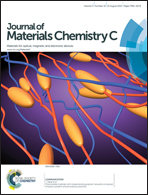How to induce highly efficient long-lasting phosphorescence in a lamp with a commercial phosphor: a facile method and fundamental mechanisms†
Abstract
We successfully tailor the properties of a well-known commercial lamp with the Zn2SiO4:Mn2+ phosphor as a novel, highly efficient, long-lasting green phosphor by using the co-doping method. The long-lasting phosphorescence (LLP) of the optimal Zn2SiO4:Mn2+,Yb3+ sample can be recorded for approximately 30 h (0.32 mcd m−2) and is visible for even more than 60 h in the dark by using dark-adapted vision. This exciting result is sufficiently encouraging for the initiation of a more thorough investigation. Several classical methods of investigation including decay curves, thermoluminescence, fading experiments, multi-peak fitting based on general-order kinetics, and first-principles calculations are used in this study to examine the LLP properties, the effects of such co-dopants and the nature of traps in detail. The important retrapping and tunneling effects, combined with a kinetics investigation, are discussed. A modified law concerning the influences of co-dopants on the traps around the Mn2+(3d5, d → d type) centers and the LLP properties are summarized. Finally, the LLP mechanism of the Zn2SiO4:Mn2+,Yb3+ phosphor is proposed.


 Please wait while we load your content...
Please wait while we load your content...